Fuzzy Comprehensive Evaluation of Human Work Efficiency in a High-Temperature Thermal-Radiation Environment
Abstract
1. Introduction
2. Methodologies
2.1. Experimental Facilities and Conditions
2.2. Participants
2.3. Test Equipment
2.4. Experimental Protocol
2.5. Cognitive Test Tasks
2.6. Subjective Survey Questionnaire
2.7. Data Processing Method
3. Evaluation Model of Personnel Work Efficiency Based on the Fuzzy Comprehensive Evaluation Method
3.1. Determine the Factor Set and Evaluation Set of the Work-Efficiency Evaluation
3.2. Determination of Membership Function and Establishment of Fuzzy Matrix R
3.3. Weight Calculation of Work-Evaluation Factor Set
- ①
- First, standardize the indexes. A positive index and a negative index have different meanings (a higher positive index value is better, and a higher negative index value is worse). Therefore, the positive index and negative index are standardized by different algorithms:
- ②
- Calculate the proportion of the i-th sample value under the j-th index to the index:
- ③
- Calculate the entropy value of the j-th index:
- ④
- Calculate the difference of information entropy:
- ⑤
- Calculate the weight of each indicator:
3.4. Comprehensive Evaluation Results
4. Discussion
5. Conclusions
Author Contributions
Funding
Institutional Review Board Statement
Informed Consent Statement
Data Availability Statement
Conflicts of Interest
References
- Hao, X.; Sun, C.; Yang, C.; Li, L.; Ma, Y.; Yin, Z. Intelligent Research and Upgrade of Narrow-band Hot-rolled Steel Production Workshop. IOP Conf. Ser. Earth Environ. Sci. 2021, 714, 032067. [Google Scholar] [CrossRef]
- Yassin, M.F. Special issue of the workshop on indoor air quality in hot arid climate. Int. J. Environ. Sci. Technol. 2019, 16, 2537. [Google Scholar] [CrossRef]
- Yang, R.L.; Liu, L.; Zhou, Y.D. Predicted Thermal Sensation Index for the Hot Environment in the Spinning Workshop. Math. Probl. Eng. 2015, 2015, 980619. [Google Scholar] [CrossRef]
- Chen, Z.H. Study on Heat Balance and Heat Stress Response of Human Body under High Temperature Working Environment and Countermeasures. Refrig. Air Cond. 2020, 34, 527–531. [Google Scholar]
- Zhai, Y.N.; Geng, D.; Huang, Y.Q.; Meng, X.J. Study on the influence of short-time thermal radiation on human physiological and cognitive ability. J. Saf. Environ. 2021, 1–13. [Google Scholar] [CrossRef]
- Moran, D.S.; Shitzer, A.; Pandolf, K.B. A physiological strain index to evaluate heat stress. Am. J. Physiol. 1998, 275, R129–R134. [Google Scholar] [CrossRef]
- Zhang, J.G.; Yang, S.H.; Suo, C.Y. Research on effects of high temperature and high humidity environment on miners’ physiology and psychology. Chin. J. Saf. Sci. 2015, 25, 23–28. [Google Scholar]
- Zuo, C.; Luo, L.; Liu, W. Effects of increased humidity on physiological responses, thermal comfort, perceived air quality, and Sick Building Syndrome symptoms at elevated indoor temperatures for subjects in a hot-humid climate. Indoor Air 2020, 32, 524–540. [Google Scholar] [CrossRef]
- Tian, X.; Fang, Z.; Liu, W. Decreased humidity improves cognitive performance at extreme high indoor temperature. Indoor Air 2020, 31, 608–627. [Google Scholar] [CrossRef]
- Yi, W.; Chan, A.P. Which Environmental Indicator Is Better Able to Predict the Effects of Heat Stress on Construction Workers. J. Manag. Eng. 2015, 31, 04014063. [Google Scholar] [CrossRef]
- Yi, W.; Chan, A.P. Optimal Work Pattern for Construction Workers in Hot Weather: A Case Study in Hong Kong. J. Comput. Civ. Eng. 2015, 29, 5014009. [Google Scholar] [CrossRef]
- Lan, L. Research on the Influence Mechanism and Evaluation of Indoor Environment on Staff Work Efficiency. Ph.D. Thesis, Shanghai Jiao Tong University, Shanghai, China, 2010. [Google Scholar]
- Zheng, G.; Li, K.; Bu, W.; Wang, Y. Fuzzy comprehensive evaluation of human physiological state in indoor high temperature environment. Build. Environ. 2019, 150, 108–118. [Google Scholar] [CrossRef]
- Witterseh, T.; Wyon, D.P.; Clausen, G. The effects of moderate heat stress and open-plan office noise distraction on SBS symptoms and on the performance of office work. Indoor Air 2010, 14, 30–40. [Google Scholar] [CrossRef]
- Hansen, A.L.; Johnsen, B.H.; Thayer, J.F. Vagal influence on working memory and attention. Int. J. Psychophysiol. 2003, 48, 263–274. [Google Scholar] [CrossRef]
- Zhou, Z.P.; Lian, Z.W.; Ye, X.J. Study on the relationship between thermal comfort and work efficiency. In Proceedings of the Annual Meeting of Shanghai Refrigeration Association; Shanghai Refrigeration Association: Shanghai, China, 2005; p. 168. [Google Scholar]
- Tiller, D.K.; Wang, L.M.; Musser, A.; Radik, M.J. Combined Effects of Noise and Temperature on Human Comfort and Performance. Ashrae Trans. 2010, 116, 522–540. [Google Scholar]
- Xu, M.; Li, B.; Yang, X.; Liu, M. An optimized method to evaluate heat stress with WBGT-index. J. Chongqing Univ. 2014, 37, 110–114. [Google Scholar]
- Niu, H.B.; Zhai, Y.N.; Huang, Y.Q.; Wang, X.L.; Wang, X.T. Investigating the short-term cognitive abilities under local strong thermal radiation through EEG measurement. Build. Environ. 2022, 224, 109567. [Google Scholar] [CrossRef]
- Zhang, D.W. Study on physiological indexes and subjective thermal sensation of human body under the radiation from local strong heat source. Master’s Thesis, Xi’an University of Architecture and Technology, Xi’an, China, 2017. [Google Scholar]
- Tu, D.X. Experiment and Research on the Human Physiological Parameters in Hot Environment with Strong Radiant Heat of Fixed Direction. Ph.D. Thesis, Tianjin University, Tianjin, China, 2010. [Google Scholar]
- Jiang, J.; Wang, D.; Liu, Y.; Xu, Y.; Liu, J. A study on pupils’ learning performance and thermal comfort of primary schools in China. Build. Environ. 2018, 134, 102–113. [Google Scholar] [CrossRef]
- ASHRAE.ANSI/ASHRAE Standard 55-2017; Thermal Environmental Conditions for Human Occupancy. American Society of Heating, Refrigerating and Air-Conditioning Engineers: Atlanta, GA, USA, 2017.
- Lan, L.; Lian, Z.; Pan, L.; Ye, Q. Neurobehavioral approach for evaluation of office workers’ productivity: The effects of room temperature. Build. Environ. 2009, 44, 1578–1588. [Google Scholar] [CrossRef]
- HART, S.; Staveland, L. Development of NASA-TLX (Task Load Index): Results of empirical and theoretical research. Adv. Psychol. 1988, 52, 139–183. [Google Scholar]
- Habib, S.; Akram, M.; Ashraf, A. Fuzzy climate decision support systems for tomatoes in high tunnels. Int. J. Fuzzy Syst. 2017, 19, 751–775. [Google Scholar] [CrossRef]
- Ashraf, A.; Akram, M.; Sarwar, M. Fuzzy decision support system for fertilizer. Neural Comput. Appl. 2014, 25, 1495–1505. [Google Scholar] [CrossRef]
- Butt, M.A.; Akram, M. A novel fuzzy decision making system for CPU scheduling algorithm. Neural Comput. Appl. 2016, 27, 1927–1939. [Google Scholar] [CrossRef]
- Akram, M.; Shahzad, S.; Butt, A.; Khaliq, A. Intuitionistic Fuzzy Logic Control for Heater Fans. Math. Comput. Sci. 2013, 7, 367–378. [Google Scholar] [CrossRef]
- Meng, X.J.; Jia, K.F.; Zhang, D.W. Fuzzy comprehensive evaluation of human physiological state in the heat stress work environment. J. Saf. Environ. 2021, 21, 1630–1635. [Google Scholar]
- Tao, H. Research on the Impact of High Temperature Noise Environment on Working Efficiency. Ph.D. Thesis, Chongqing University, Chongqing, China, 2019. [Google Scholar]
- Zhou, S.H.; Xing, J.; Zhang, Y.; Guo, H.; Huang, Y.; Zhou, S. An assessment model based on the hierarchical fuzzy analysis process for the bedding slope with the prestressed anchor cable frame reinforcement. J. Saf. Environ. 2020, 20, 1695–1704. [Google Scholar]
- Zhou, X.; Li, S.L.; Zheng, J.Y.; Liu, Q.Y.; Zhang, W. Literature analysis of human factors and ergonomics simulation and evaluation software. Hum. Effic. Sci. 2020, 26, 61–65. [Google Scholar]
- Li, J.W.; Dong, J.; Zhang, L.P. Comprehensive evaluation of vulnerable nodes based on membership function of grade division. Electr. Meas. Instrum. 2020, 59, 1–9. [Google Scholar]
- Liu, G.D.; Ji, Y.X.; Teng, R.; Liang, S.W.; Wang, Z.X.; Li, C.R. Control strategy of outer louver shading considering light-thermal coupling comprehensive energy consumption based on entropy weight method. J. Sol. Energy 2022, 43, 236–241. [Google Scholar]
- DU, Y.N. The effect of thermal environment on human work performance. Low Temp. Build. Technol. 2018, 40, 137–139. [Google Scholar]
- Li, L.; Lian, Z.W. Use of neurobehavioral tests to evaluate the effects of indoor environment quality on productivity. J. Saf. Environ. 2009, 44, 2208–2217. [Google Scholar]
- Zhang, S.; Zhu, N.; Lu, S.L. Human response and productivity in hot environments with directed thermal radiation. Build. Environ. 2021, 187, 107408. [Google Scholar] [CrossRef]
- Wang, D.J.; Xu, Y.C.; Liu, Y.F. Experimental investigation of the effect of indoor air temperature on students’ learning performance under the summer conditions in China. Build. Environ. 2018, 140, 140–152. [Google Scholar] [CrossRef]
- GBZ2.2-2007; Occupational Exposure Limits for Hazardous Factors in the Workplace Part 2: Physical Factors. Standards Press of China: Beijing, China, 2007.
- GBZ/T229.3-2010; Classification of Occupational Hazards in the Workplace Part 3: High Temperature. Standards Press of China: Beijing, China, 2010.
- Zhang, C.; Tang, S.C.; Li, D.M.; Xing, J.J.; Xu, A.M.; Li, J. Study on human labor load and fatigue level in high temperature and high humidity environment. J. Saf. Environ. 2015, 15, 176–180. [Google Scholar]
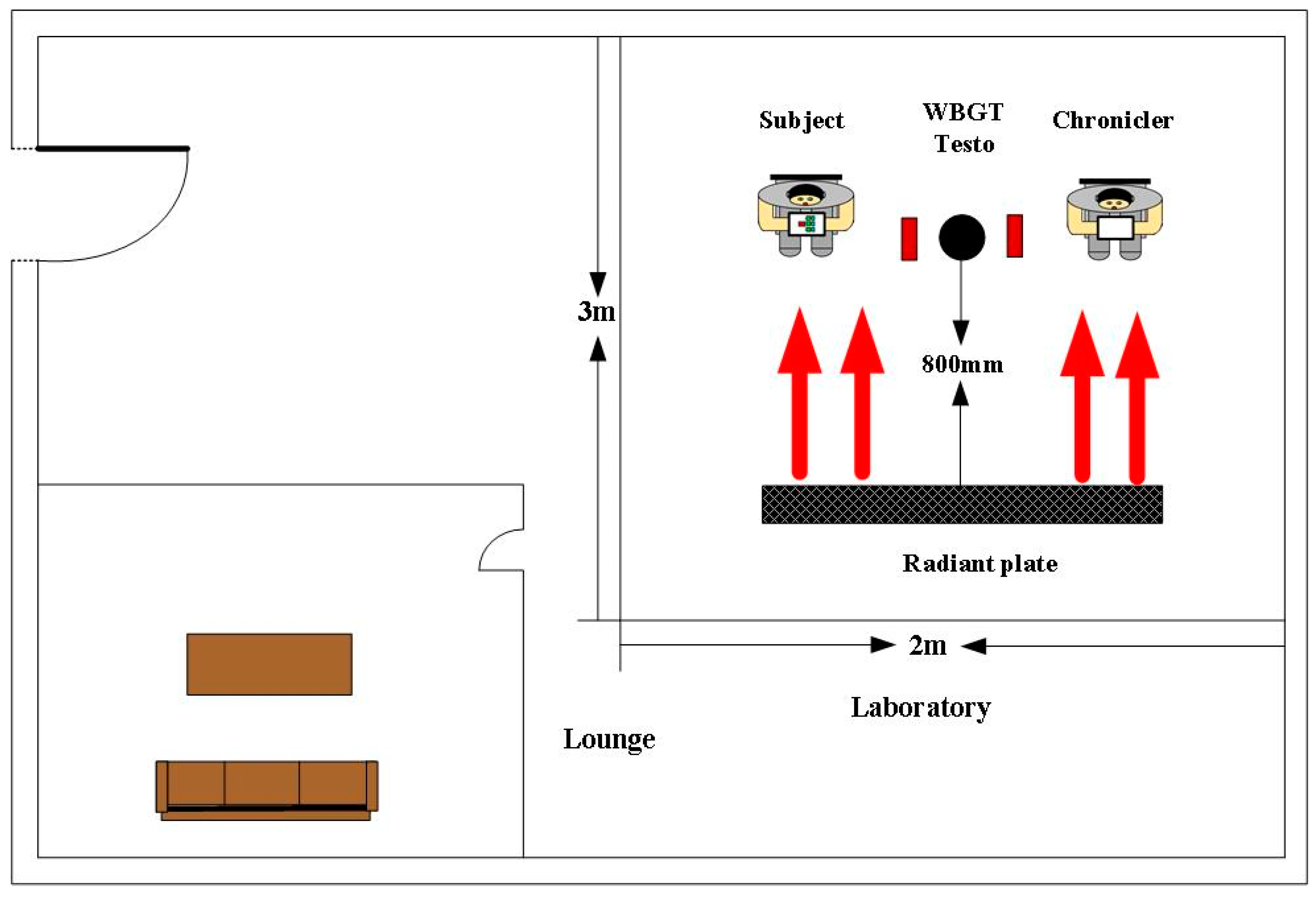
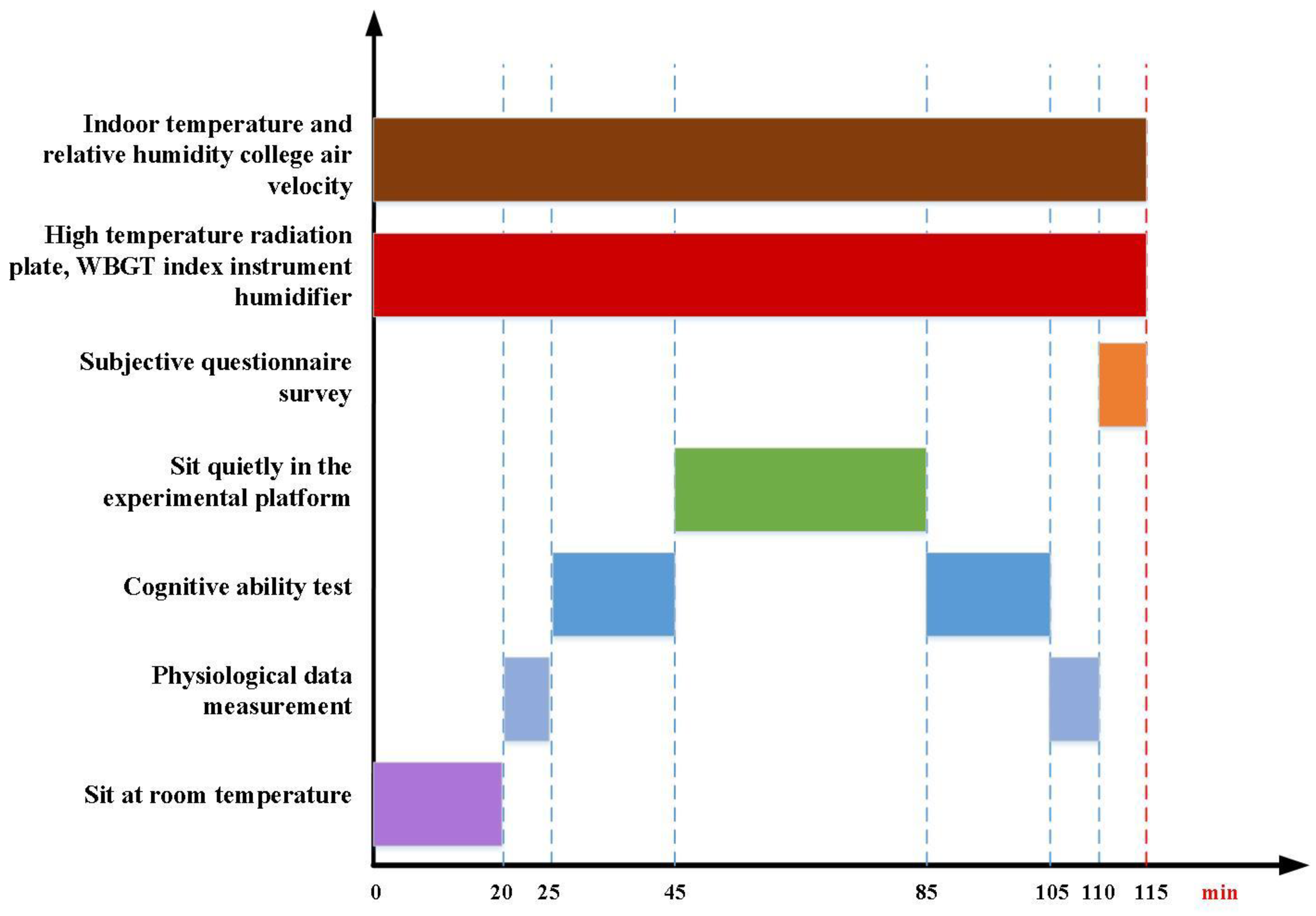
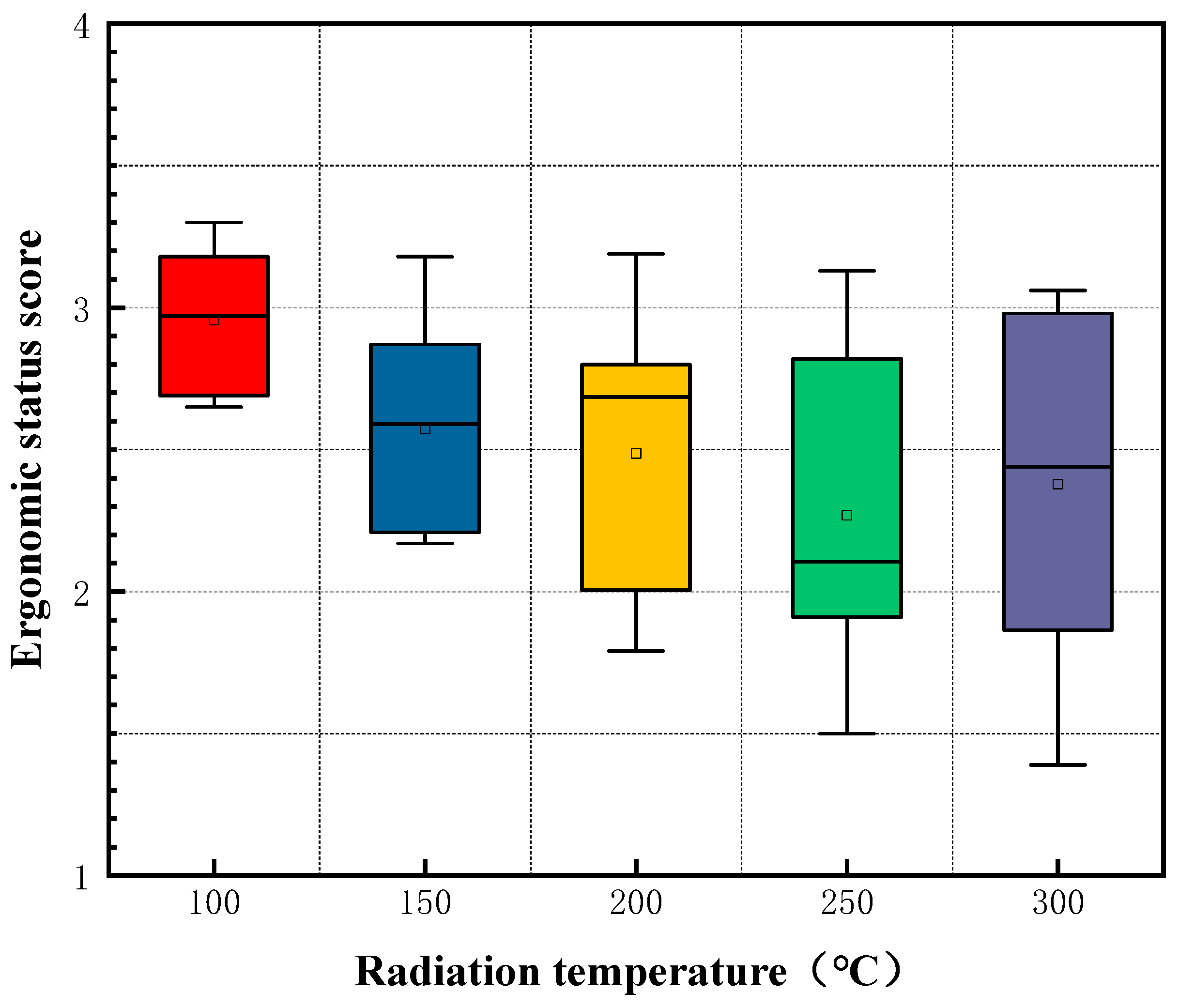
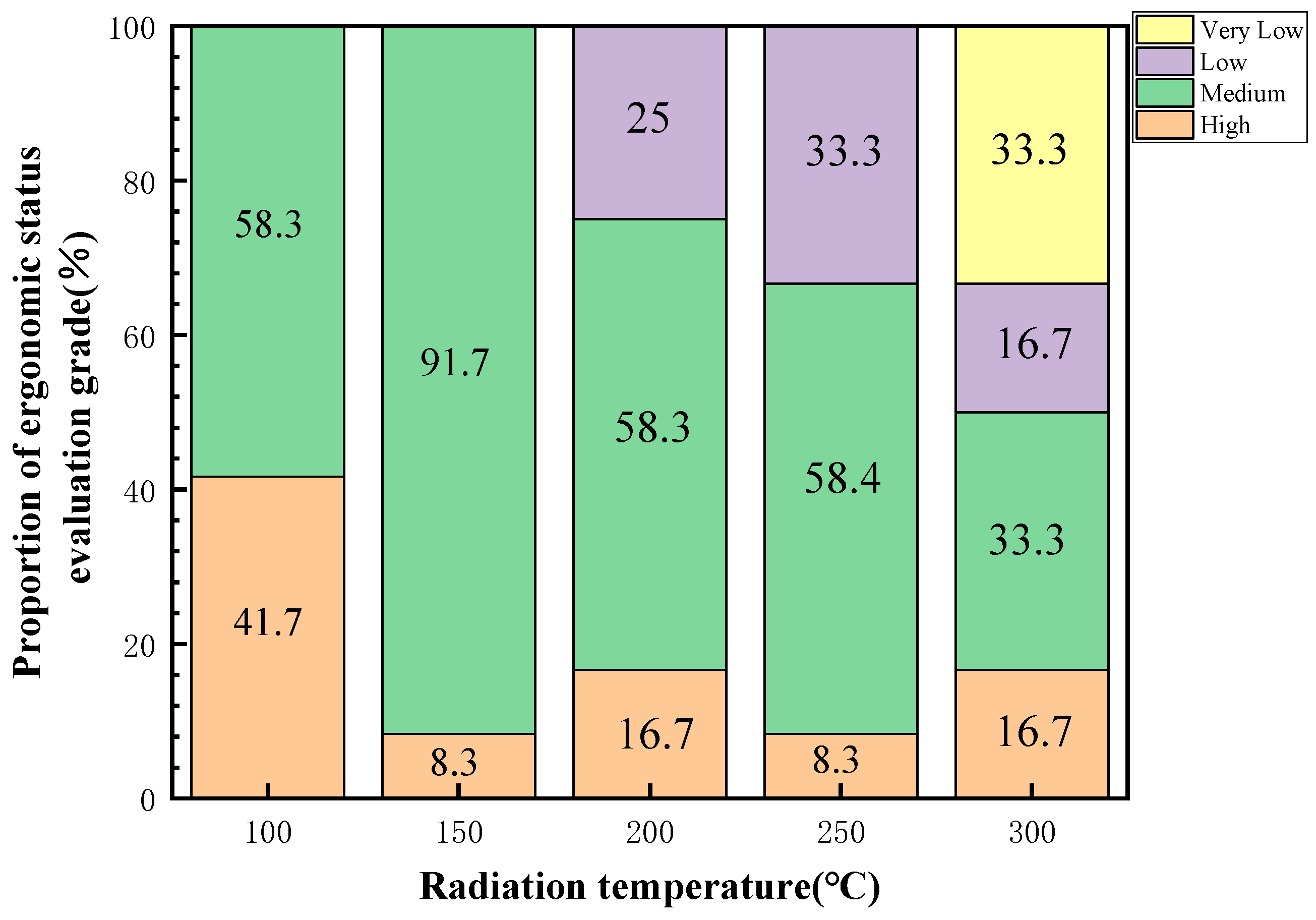
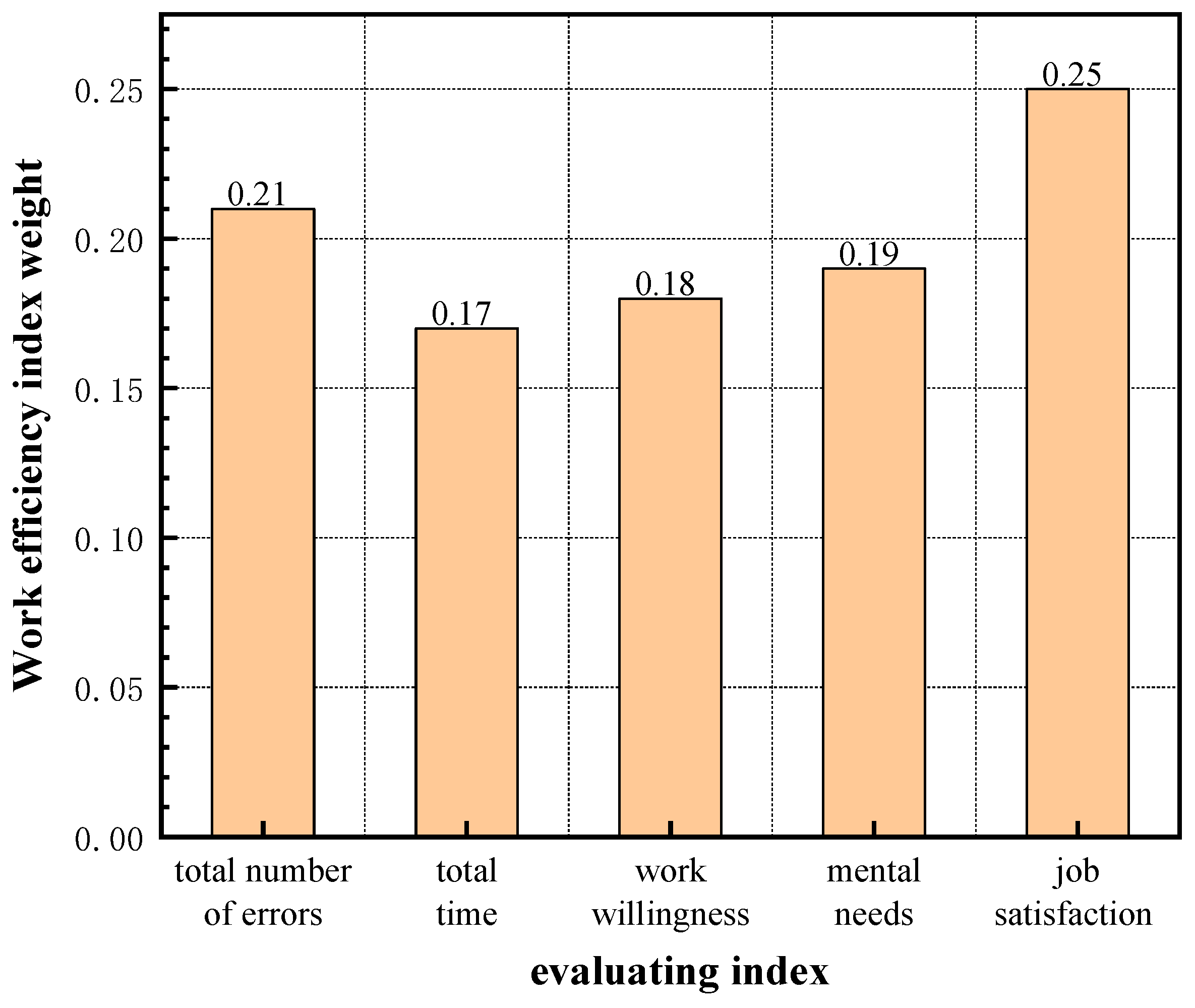
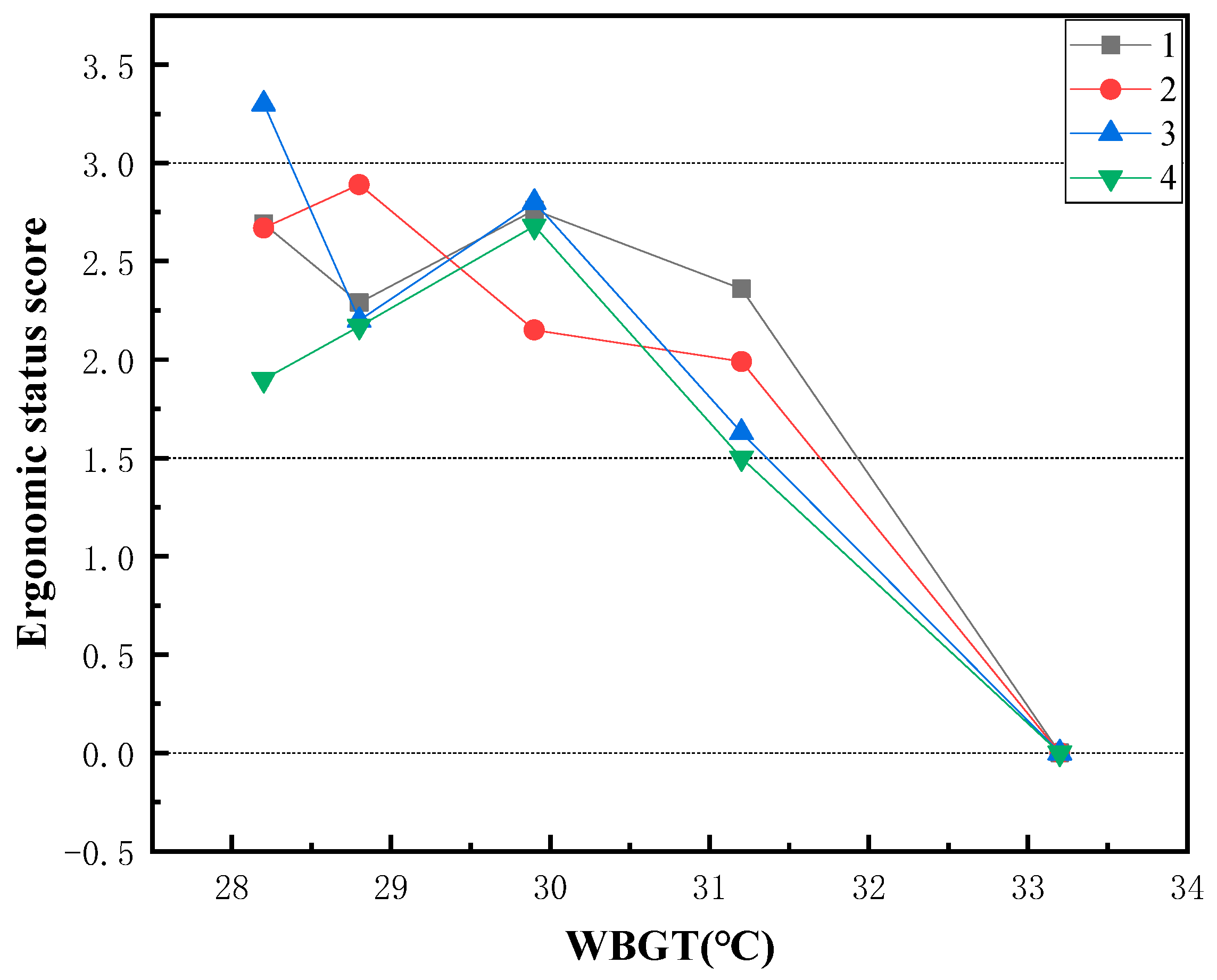
| Test Parameter Name | Equipment | Type | Range and Accuracy | Instrument |
|---|---|---|---|---|
| WBGT temperature | Index of WBGT-2006 m | WBGT-2206 | Accuracy of ±0.5 °C |  |
| Radiant panel | Curved surface high Temperature radiant electric heater | XLQ-4000 | Power 4000 W, rated frequency 50 HZ, 1500 mm × 390 mm |  |
| Environment temperature Relative humidity | Testo temperature and humidity meter | 605 i | −20–60 °C 0–100% |  |
| Wind speed | Testo anemometer | 405 i | Scope of 0–30 m/s |  |
| Body temperature | Non-contact infrared frontal temperature meter | DT-8806H | Distance: 1–15 cm, precision ±0.2 °C |  |
| Systolic and diastolic blood pressure and heart rate | Omron electronic blood pressure monitor | U12 | Scope of 0–39.9 kpa, precision ±0.4 kpa |  |
| Oxygen saturation, pulse | Pulse oximetry | Prince-100 A | Scope of 35–100% |  |
| Testing Capability | Test Project | Test Content | Legend |
|---|---|---|---|
| Perception | Find the difference | Find the different graphics among 120 graphics Within the specified time |  |
| Find the target graphic | Find out the figure given by the topic from 36 different figures. |  | |
| Memory | Digital memories | A series of meaningless numbers are randomly given on the screen. Remember the numbers within the specified time and write them correctly. Write errors or timeouts are errors. |  |
| Matching memory | Pairwise pairing is done by flipping over the graph a limited number of times. An error will occur if the number of times is exceeded. |  | |
| Thought | Rapid calculation | In a certain period of time, arrive at the answers of five mixed numbers through mental arithmetic and then select the correct option. |  |
| Alertness | 1 to N | Under the premise of allowing three chances for error, the subjects were asked to click from small to large among N discontinuous numbers. |  |
| Test Items | 100 °C | 150 °C | 200 °C | 250 °C | 300 °C |
|---|---|---|---|---|---|
| Total number of errors | 2.3 | 2.5 | 2.9 | 3 | 3.25 |
| Total time | 932.2 | 944.5 | 906.7 | 941.9 | 870.4 |
| Work willingness | 2.75 | 4.5 | 6.1 | 7.6 | 7.7 |
| Mental demand | 6.6 | 5.8 | 7.1 | 5.2 | 8.9 |
| Job satisfaction | 2.5 | 3.6 | 3.4 | 3.7 | 5.5 |
| Test Items | High | Medium | Low | Very Low |
|---|---|---|---|---|
| Total number of errors | [0–1) | [1–3) | [3–5) | [5–10) |
| Total time | [750–840) | [840–950) | [950–1100) | [1100–1300) |
| Work willingness | [0–2) | [2–5) | [5–8) | [8–10) |
| Mental demand | [0–2) | [2–5) | [5–8) | [8–10) |
| Job satisfaction | [0–2) | [2–5) | [5–8) | [8–10) |
| Evaluation Grade | Membership Function |
|---|---|
| High | |
| Medium | |
| Low | |
| Very Low |
| Comprehensive Evaluation Result Vector | High | Medium | Low | Very Low |
|---|---|---|---|---|
| B1 | 0.12 | 0.45 | 0.43 | 0 |
| B2 | 0 | 0.4 | 0.5 | 0.11 |
| B3 | 0.13 | 0.5 | 0.37 | 0 |
| B4 | 0 | 0.43 | 0.5 | 0.07 |
| B5 | 0.3 | 0.43 | 0.27 | 0 |
| Index | Evaluation Grade | |||
|---|---|---|---|---|
| High | Medium | Low | Very Low | |
| ESS | [3.0,4.0] | [2.0,3.0] | [1.0,2.0] | [0,1.0] |
| Radiation Temperature (°C) | 100 | 150 | 200 | 250 | 300 |
|---|---|---|---|---|---|
| WBGT (°C) | 28.21 ± 0.3 | 28.83 ± 0.5 | 29.94 ± 0.7 | 31.23 ± 0.6 | 33.16 ± 0.8 |
| Indoor temperature (°C) | 33.75 ± 0.4 | 34.8 ± 0.6 | 37.9 ± 1 | 40.8 ± 1.5 | 45.39 ± 1.4 |
| Relative humidity (%) | 46.58 ± 1.8 | 47.55 ± 1.7 | 44.34 ± 2.5 | 44.83 ± 3 | 42 ± 1.5 |
| Heat radiant flux (KW/m2) | 0.19 | 0.32 | 0.5 | 0.75 | 1.1 |
Publisher’s Note: MDPI stays neutral with regard to jurisdictional claims in published maps and institutional affiliations. |
© 2022 by the authors. Licensee MDPI, Basel, Switzerland. This article is an open access article distributed under the terms and conditions of the Creative Commons Attribution (CC BY) license (https://creativecommons.org/licenses/by/4.0/).
Share and Cite
Zhai, Y.; Wang, X.; Niu, H.; Wang, X.; Nie, Y.; Huang, Y. Fuzzy Comprehensive Evaluation of Human Work Efficiency in a High-Temperature Thermal-Radiation Environment. Sustainability 2022, 14, 13959. https://doi.org/10.3390/su142113959
Zhai Y, Wang X, Niu H, Wang X, Nie Y, Huang Y. Fuzzy Comprehensive Evaluation of Human Work Efficiency in a High-Temperature Thermal-Radiation Environment. Sustainability. 2022; 14(21):13959. https://doi.org/10.3390/su142113959
Chicago/Turabian StyleZhai, Yingni, Xinta Wang, Haobo Niu, Xianglin Wang, Yangwen Nie, and Yanqiu Huang. 2022. "Fuzzy Comprehensive Evaluation of Human Work Efficiency in a High-Temperature Thermal-Radiation Environment" Sustainability 14, no. 21: 13959. https://doi.org/10.3390/su142113959
APA StyleZhai, Y., Wang, X., Niu, H., Wang, X., Nie, Y., & Huang, Y. (2022). Fuzzy Comprehensive Evaluation of Human Work Efficiency in a High-Temperature Thermal-Radiation Environment. Sustainability, 14(21), 13959. https://doi.org/10.3390/su142113959





